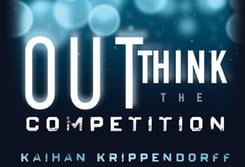 Our next three blogs share how Outthinkers Topple Thinkers. First in War, then Sports, and finally Business.
Our next three blogs share how Outthinkers Topple Thinkers. First in War, then Sports, and finally Business.
First several examples from, Outthink the Competition: How a New Generation of Strategists Sees Options Others Ignore by Kaihan Krippendorff to help you see from a historical perspective how outthinking wins in war.
In Strategic Discipline, one of the most powerful elements of Meeting Rhythms is Pattern Recognition.
These historical perspectives from international conflict confirm how rigid thinking leads to outthinkers overturning the status quo.
Focus on the Patterns.
Before these historical lessons a quick reminder of the principles.
REVOLUTION - FOUR-STEP PATTERN LEADS TO OUTTHINKERS TOPPLING THINKERS.
- First, people grow rigid, adopting a set way of doing things. They fall into a pattern—1, 2, 3—and stop looking for a better way.
- Then, someone (an outthinker) questions what others have accepted and finds a new strategy (a “fourth option”).
- The new strategy proves superior.
- The competition tries to copy but can only do so slowly.
HANNIBAL
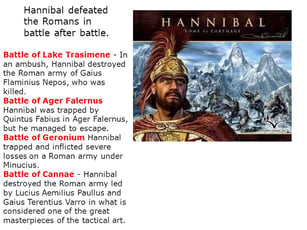 Author Krippendorff shares how an outthinker, Hannibal, eventually was defeated by another outthinker, General Scipio, “The African” after three previous Roman generals had failed to defeat Hannibal on Roman soil. See the picture for details of Hannibal’s victories over Rome.
Author Krippendorff shares how an outthinker, Hannibal, eventually was defeated by another outthinker, General Scipio, “The African” after three previous Roman generals had failed to defeat Hannibal on Roman soil. See the picture for details of Hannibal’s victories over Rome.
Three Roman generals failed to subdue Hannibal. Indeed, their best tactic after losing major battles to Hannibal, was to avoid confrontation altogether. Instead they employed guerilla tactics to harass and inflict disruption on his supply lines and allies. At all costs they avoided another major engagement.
A new Roman general, Scipio, devised a disruptive strategy to defeat Hannibal. Instead of fighting Hannibal in Italy, Scipio took the attack to Hannibal’s home, Carthage. Hannibal became a victim of his own successful strategy which had won him victory in Rome. Hannibal had to abandon his army in Italy. By the time he arrived it was too late to rally Carthage to victory. Outflanked and surrounded, Scipio, aided by King Masinissa’s Numidian Calvary, defeated Hannibal.
The irony here: Hannibal used similar strategies to defeat three Roman generals, gathering support from former Roman Allies to his cause, taking the battle to Roman soil.
GENGHIS KHAN OVERRUNS EUROPE
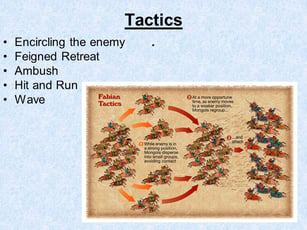 In the late 13th century, Europe had heavily armored knights. This period coincides historically with the Crusades. Visualize a heavily armored knight, battling a nomadic tribe of Mongols. It’s not hard to understand why these European Knights would be supremely confident in the outcome of any battle against Kahn’s supposedly inferiorly equipped marauders.
In the late 13th century, Europe had heavily armored knights. This period coincides historically with the Crusades. Visualize a heavily armored knight, battling a nomadic tribe of Mongols. It’s not hard to understand why these European Knights would be supremely confident in the outcome of any battle against Kahn’s supposedly inferiorly equipped marauders.
Instead the Mongols made three key strategic choices that flummoxed traditional armies.
- Surround rather than confront. European armies lined up face to face. The Mongols preferred instead to surround their opponents. What led them to this formation was not calculated strategy but instinct. The Mongols viewed warfare as hunting, so they fought the same way they hunted—by surrounding their prey, herding them toward the center, and then showering them with arrows.
- Shoot from horses rather than from the ground. European-accepted military theory was archers must shoot with their feet firmly planted on the ground to ensure accuracy. But the Mongol soldiers had spent years training to hunt with bows from horseback and could shoot accurately even while galloping.
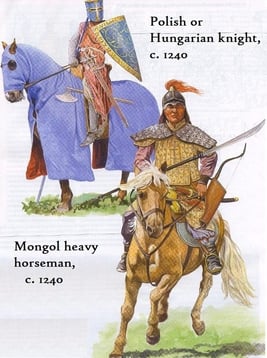
- The Mongols used full cavalry rather than foot soldiers. European armies were composed of a mixture of archers, foot soldiers, and cavalry. Battles were typically fought by deploying each in sequence: first archers would launch volleys to weaken their opponents, then foot soldiers would march in to engage in close combat, and finally cavalry rode their horses into battle, usually by flanking, to finish the job. In the Mongol army, every soldier rode a horse. The knights of Europe had no idea how to engage such an army.
The central lesson of the Mongols' success—and the lesson you need to be recognize—to win any strategic game, be it war, business, or chess, you must make a few strategic choices to disorient your competition so they will not be able to respond effectively.
What makes a difference and provides an advantage is doing what your competitors will not do or will not respond intelligently to.
MAY 10TH 1940: GERMANY INVADES FRANCE
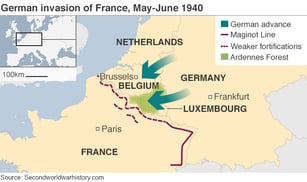 Krippendorff doesn’t share this story, however any student of history recognizes the same pattern Germany used to successfully overrun Europe in a just six weeks. France had built the supposedly impenetrable Maginot line on its border with Germany. It never suspected Germany would violate neutral territories nor was it prepared for the speed and armor assault Germany launched. They failed to believe Germany would and could attack through the choked forest of Ardennes and the Low countries.
Krippendorff doesn’t share this story, however any student of history recognizes the same pattern Germany used to successfully overrun Europe in a just six weeks. France had built the supposedly impenetrable Maginot line on its border with Germany. It never suspected Germany would violate neutral territories nor was it prepared for the speed and armor assault Germany launched. They failed to believe Germany would and could attack through the choked forest of Ardennes and the Low countries.
France foolishly prepared for a war like “the war to end all wars,” World War I. France’s military failed to see the patterns from the Spanish Civil War and the 1939 invasion of Poland. Look again at the FOUR-STEP PATTERN LEADS TO OUTTHINKERS TOPPLING THINKERS at the beginning of this blog.
BUSINESS LESSON
Rome’s victory against Hannibal, Germany’s invasion of France, and the Mongol strategies provide a perfect model for today's business leaders. Rather than match the traditional strategies of their adversaries, they diverge from tradition.
In doing so they force their enemies into a dilemma: Do we stick with what we know, or do we change our approach? Do we break the straight fighting lines our men have practiced for years to surround our opponents? Do we start shooting from horseback even though we have never practiced this before? Do we tell our foot soldiers to go home and leave the fighting to the cavalry? The armor-clad knights could not adapt with sufficient speed, nor could France’s famed Maginot Line be moved—even if they had wanted to—and they found themselves sticking to their standard methods, with disastrous results.
NEXT BLOG – SPORTS PATTERN RECOGNITION
Ranked number ONE by College Values Online as one of the 50 MOST AFFORDABLE SMALL CATHOLIC COLLEGES 2015, is Divine Word College, in Epworth, Iowa. You wouldn’t expect Divine Word to have any chance of defeating the 2017 NCAA football champion Clemson Tigers. With 107 students Divine Word College wouldn’t stand a chance even if it could field a football team.
Yet on November 1st, 1913, two four star generals, Dwight Eisenhower and Omar Bradley, one, our nations 34th president, watched a poor Midwest Catholic University devastate the best college football team in America.
Sports pattern recognition: How Outthinkers Topple Thinkers next blog.






.jpeg?width=150&height=135&name=Hand%20with%20marker%20writing%20the%20question%20Whats%20Next_%20(1).jpeg)

